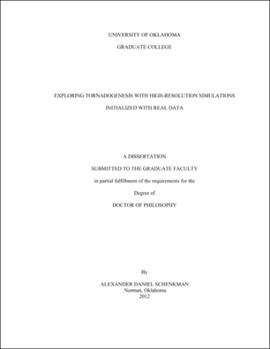| dc.contributor.advisor | Xue, Ming | |
| dc.creator | Schenkman, Alexander Daniel | |
| dc.date.accessioned | 2019-04-27T21:25:03Z | |
| dc.date.available | 2019-04-27T21:25:03Z | |
| dc.date.issued | 2012 | |
| dc.identifier | 99171564702042 | |
| dc.identifier.uri | https://hdl.handle.net/11244/318637 | |
| dc.description.abstract | Despite large advances in our understanding of tornadogenesis over the past fifty years, a comprehensive dynamical understanding of the processes behind tornado formation remains elusive. The purpose of this dissertation is to augment the current body of knowledge by exploring the dynamical processes responsible for tornadogenesis using high-resolution numerical weather prediction. To accomplish this goal, two high-resolution numerical simulations of tornadic storms were performed with the Advanced Regional Prediction System (ARPS) model. Both simulations were nested within lower-resolution domains that were initialized via high-frequency (5 min) data assimilation cycles conducted with the ARPS three dimensional variational (3DVAR) data assimilation package. Radar reflectivity and radial velocity, in addition to conventional observations, were assimilated in these five-minute assimilation cycles. In both simulations, tornadogenesis timing and location were well forecast. | |
| dc.description.abstract | The first simulation examined used 100-m grid spacing to simulate a tornadic mesovortex. The mesovortex was one of two tornadic mesovortices spawned by a mesoscale convective system (MCS) that traversed southwest and central Oklahoma on 8-9 May 2007. | |
| dc.description.abstract | Results from the 100-m simulation provide a detailed picture of the development of a mesovortex that produces a sub-mesovortex-scale tornado-like vortex (TLV). Closer examination of the genesis of the TLV suggests that a strong low-level updraft is critical in converging and amplifying vertical vorticity associated with the mesovortex. Vertical cross-sections and backward trajectory analyses from this low-level updraft reveal that the updraft is the upward branch of a strong rotor that forms just northwest of the simulated TLV. The horizontal vorticity in this rotor originates in the near surface inflow and is caused by surface friction. An additional simulation with surface friction turned off does not produce a rotor, strong low-level updraft, or TLV. Comparison with previous two-dimensional numerical studies of rotors in the lee of mountains shows striking similarities to the rotor formation presented herein. | |
| dc.description.abstract | This study is the first to simulate, analyze, and propose a dynamical mechanism responsible for mesovortex tornadogenesis. This dynamical mechanism is summarized in a four-stage conceptual model that describes the evolution of the event from mesovortexgenesis through rotor development and finally TLV genesis and intensification. | |
| dc.description.abstract | The second case examined is a 50-m grid spacing simulation of the 8 May 2003 Oklahoma City tornadic supercell. This thunderstorm produced a strong, long-track tornado that produced F-4 damage on the south side of Oklahoma City. A 40-min forecast run on the 50-m grid produces two tornadoes that track within 10 km of the location of the observed long-track tornado. | |
| dc.description.abstract | The development of both simulated tornadoes is analyzed and presented with unprecedented detail in order to determine the processes responsible for tornadogenesis. This analysis reveals that tilting of low-level vorticity generated by surface drag plays an important role in the origin of vertical vorticity near the ground for both tornadoes. This result represents the first time that such a mechanism has been shown to be responsible for generating near-surface vertical vorticity leading to tornadogenesis. Two conceptual models are presented that summarize the development of the first and second tornado, respectively. | |
| dc.description.abstract | A simulation run without surface drag was found to be considerably different from the simulated with drag included. A tornado still developed in the no-drag simulation, but it was shorter-lived and took a substantially different track than the tornadoes in the drag simulation. Tilting of environmental vorticity in an outflow surge was determined to be the most likely cause of the tornado in the no-drag simulation. | |
| dc.description.abstract | Baroclinic vorticity generation was found to be unimportant in the development of the tornadoes in both the drag and the no-drag simulation. This is a marked departure from current theories of tornadogenesis and the broader implications of this finding, in addition to the important discovery of the substantial role of surface drag in the origins of near-surface vertical vorticity in the drag simulation, are discussed. | |
| dc.description.abstract | Errors in trajectory analysis are also discussed. A simple, one-dimensional flow is invoked to demonstrate the sensitivities of trajectory analysis to divergent/convergent flows. Possible remedies and alternatives to trajectory analysis are proposed for future work. | |
| dc.format.extent | 186 pages | |
| dc.format.medium | application.pdf | |
| dc.language | en_US | |
| dc.relation.requires | Adobe Acrobat Reader | |
| dc.subject | Tornadoes | |
| dc.subject | Numerical weather forecasting | |
| dc.subject | Severe storms | |
| dc.title | Exploring Tornadogenesis with High-Resolution Simulations Initialized with Real Data | |
| dc.type | text | |
| dc.type | document | |
| dc.thesis.degree | Ph.D. | |
| ou.group | College of Atmospheric & Geographic Sciences::School of Meteorology | |
